The Traditional GPS 🗺️ Asking for and Giving Directions in Spanish
Understanding Directions
in Spanish // Vocab and FREE QUIZ
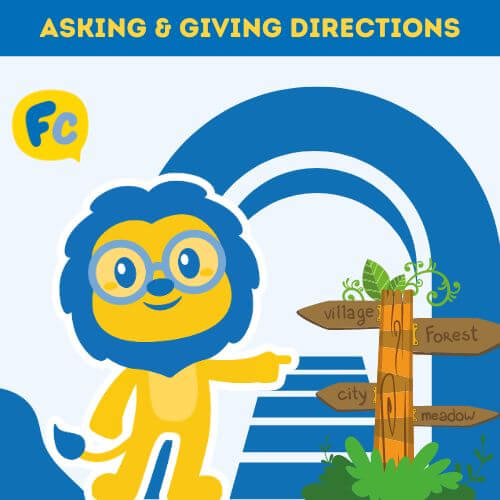
When travelling to a Spanish-speaking country, one of the most valuable skills you can have is the ability to ask for directions.
Whether you’re exploring city streets, finding your way through a small town, or navigating a bustling market, knowing how to ask for directions in Spanish can make your journey smoother and more enjoyable.
In this blog, we’ll walk you through the essential vocabulary, phrases and tips needed to ask for directions, helping you find your way with ease.
Let’s break down asking for and giving directions in español!
Directions in Spanish || Asking for Directions in Spanish
Directions in Spanish || Giving and Understanding Directions in Spanish
Directions in Spanish || Common Phrases and Vocabulary To Get Around
Directions in Spanish || Quiz
Directions in Spanish || FAQs
Directions in Spanish || Asking for Directions
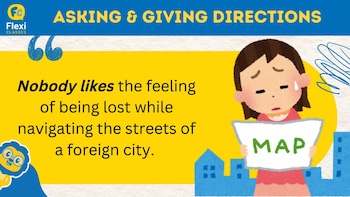
🗯 Let’s tackle that (when it comes to Spain at least) and grab the bull by the horns.
Let’s learn the essentials of asking directions in Spanish.
🌟 A prior note, always remember that when addressing and approaching a stranger for directions, it is usually best to use the formal “you”.
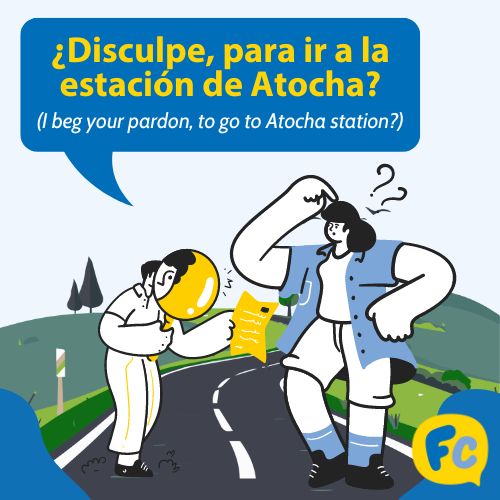
And now down to business.
Use these key phrases to never get lost again in Spain, ideally accompanied by gracias (thank you) and por favor (please), as we are asking a stranger to spare their time and attention to help us out.
Want to find a landmark or a street?
¿Disculpe, para ir a…? (I beg your pardon, to go to…?) and fill in the blanks, like so:
¿Disculpe, para ir a la estación de Atocha?
(I beg your pardon, to go to Atocha station?)¿Perdón, me podría decir dónde está… (Excuse me, could you please tell me where … is?) and fill in the blanks, like so:
¿Perdón, me podría decir dónde está la catedrál?
(Excuse me, could you please tell me where the cathedral is?)¿Disculpe, me puede indicar por favor cómo llegar a …? (I beg your pardon, could you please tell me how to get to …?) and fill in the blanks, like so:
¿Disculpe, me puede indicar por favor cómo llegar a la calle Alcalá?
(I beg your pardon, could you please tell me how to get to Alcalá Street?)
| spanish | english |
|---|---|
| ¿Disculpe, para ir a…? | I beg your pardon, to go to…? |
| ¿Perdón, me podría decir dónde está…? | Excuse me, could you please tell me where … is? |
| ¿Disculpe, me puede indicar por favor cómo llegar a …? | I beg your pardon, could you please tell me how to get to …? |
Would you like to ask for help for more proactive assistance in getting directions?
| spanish | english |
|---|---|
| Disculpe, me he perdido, me podría ayudar por favor. | I beg your pardon, I am lost, could you please help me? |
| ¿Me puede ayudar por favor? | Could you please help me? |
Some other useful phrases for when asking for directions
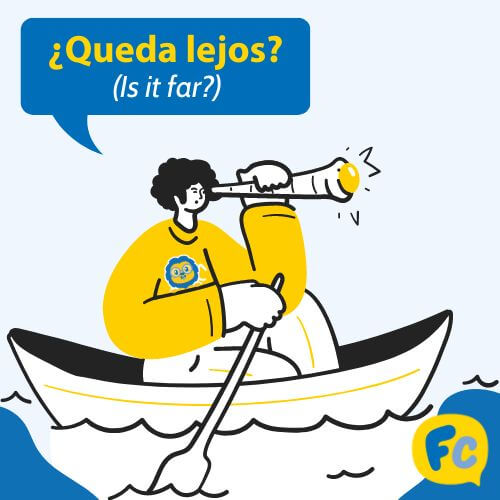
¿Queda lejos? (Is it far?) or lejos de aquí (far from here), like for example:
| spanish | english |
|---|---|
| ¿Queda lejos el aeropuerto? | Is the airport far away? |
| ¿Disculpe, el Museo de Arte Contemporáneo queda lejos de aquí? | I beg your pardon, is the Museum of Contemporary Art far from here? |
| ¿Está cerca? | Is it near? |
| Cerca de aquí, como por ejemplo: | Nearby, like for example: |
| ¿Hay alguna farmacia cerca de aquí? | Is there a nearby pharmacy? |
| Desde aquí, como por ejemplo: | From here, like for example: |
| ¿Cómo se llega a la parada de autobús desde aquí? | How do you get to the bus stop from here? |
Directions in Spanish ||
Giving and Understanding Directions
Understanding directions in Spanish is key, not only when giving them but when receiving them as well. So let’s break down the main directions you will need to survive a navigational hazard.
“Go straight” and its variants
Sigue recto literally translates to “continue straight” while tira recto and ve recto equate to “go straight” when using the informal (singular) “you” to address the person requesting directions.
Siga recto literally translates to “continue straight” while tire recto and vaya recto equate to “go straight” when using the formal (singular) “you” to address the person requesting directions.
| go straight (Informal) | Go straight (FORMAL) | continue straight |
|---|---|---|
| Tira recto | Tire recto | Sigue recto |
| Ve recto | Vaya recto | Siga recto |
Here are some examples of use:
| spanish | english |
|---|---|
| Sigue recto hasta llegar a la intersección. | Continue straight until you get to the intersection. |
| Justo después de la floristería, tire recto. | Right after the flower shop, go straight. |

“Turn right” and its variants
Girar a la derecha translates to “turn right” and torcer a la derecha, would be more similar to “make a right”. Here are some examples of use:
| spanish | english |
|---|---|
| Después del semáforo, gire a la derecha. | After the stoplight, turn right. |
| Tuerza a la derecha tras la segunda manzana. | Make a right after the second block. |
“Turn left” and its variants
Girar a la izquierda translates to “turn left” and torcer a la izquierda, would be more similar to “make a left”. Here are some examples of use:
| spanish | english |
|---|---|
| Al llegar al kiosko de la esquina, gire a la izquierda. | When you get to the corner kiosk, turn left. |
| En unos cien metros, tuerza a la izquierda. | In about one hundred meters, make a left. |
Some other useful phrases for when asking for directions
Al lado (beside), like in the example:
Al lado del banco, verá el cajero automático.
(Beside the bank, you will see the ATM.)Cruzar la calle (cross the street), like in the example:
Cuando vea la farmacia, cruce la calle.
(When you see the pharmacy, cross the street.)BONUS || Want to feel lost in a whole new language? Check out how to say Directions in Chinese and Directions in Japanese
Directions in Spanish ||
Common Phrases and Vocabulary To Get Around
When referring to modes of transport:
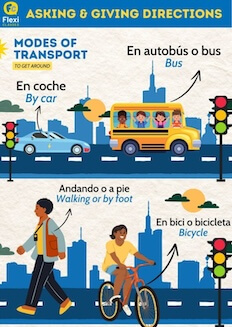
| spanish | english |
|---|---|
| Ir | To go |
| Andando o a pie | Walking or by foot |
| En coche | By car |
| En transporte público | In public transportation |
| En metro | Subway |
| En autobús o bus | Bus |
| En moto | Motorbike |
| En patinete eléctrico | Electric scooter |
| En bici o bicicleta | Bicycle |

A Handy Tool – the Best Free Spanish Learning App
Get Some Extra Learning Mileage With The Best Free Spanish Learning App Disclaimer: Opinions expressed in this article are based on personal experience of use of the app as well as on supporting extensive research and comparative data online done…
Need clarifications?
Ask to repeat: Me podría repetir por favor cómo llegar a…? (Could you please repeat how to get to…?) and fill in the blanks, like in the example:
Me podría repetir por favor cómo llegar a Madrid en coche?
(Could you please repeat how to get to Madrid by car?)To confirm the directions given:
Entonces, tengo que… (So then, I have to…) and fill in the blanks, like in the example:
| spanish | english |
|---|---|
| ¿Entonces tengo que seguir recto y después girar hacia la derecha? | So then I have to continue straight and then turn right? |
| Si lo he entendido bien… | If I understood correctly… |
| Si lo he entendido bien, tras la señal de tráfico, veré el restaurante… | If I understood correctly, after the traffic sign, I will see the restaurant… |
Need help interpreting with visual guides if you have a map or Google Maps: ¿Me lo puede mostrar por favor? (Could you please point it out to me?), like in this example:
¿Me lo puede mostrar en Google Maps por favor?
(Could you please point it out to me in Google Maps?)Urban landscape vocabulary
| spanish | english |
|---|---|
| Manzana | Block |
| Calle | Street |
| Metros | Meters |
| Esquina | Corner |
| Cruce o Intersección | Crossing or Intersection |
| Semáforo | Stoplight |
| Paso de peatones | Pedestrian Lane |
| Parada de autobús | Bus Stop |
| Estación de metro | Subway Station |
| Acera | Sidewalk |
| Farola | Streetlamp |
| Señal de tráfico or señalization | Traffic Sign |
| Puente | Bridge |
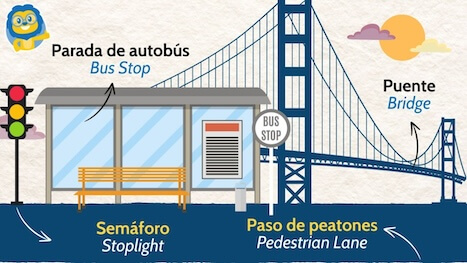
More directionals (with examples of use)
| Spanish | English | Example of Use |
|---|---|---|
| Subir | to go up | Suba por las escaleras mecánicas. (Go up the mechanical stairs.) |
| Bajar | to get off or to go down | Baje en la parada de metro de Plaza Cataluña. (Get off in the Plaza Cataluña metro station.) |
| Pasar por | pass by | Pase por la carretera comarcal y evitará el atasco. (Pass by the secondary highway and will avoid the traffic jam.) |
| Encima de | on top | La casa está encima de la colina. (The house is on the top of the hill.) |
| Alrededor de | around | Alrededor de la estación hay muchos carteristas. (Around the station there are many pickpockets.) |
| Debajo | under/underneath | Hay un jardín bonito debajo del puente. (There is a beautiful garden under the bridge.) |
| Delante | in front | El banco está delante de la panadería. (The bank is in front of the bakery.) |
| Detrás/atrás | behind/back | La puerta de acceso está en la calle de atrás. (The access door is in the back street.) |
Directions in Spanish || Quiz
Now you’ve mastered Directions, check out these Spanish essentials:
👉 Tips on How to Flirt in Spanish
Directions in Spanish || FAQs
What are the directions north, south, east and west in Spanish?
The cardinal directions in Spanish, mostly used when reading/interpreting maps (yes Google Maps, too) and when referring to compass points, are the following:
Norte (North)
Sur (South)
Este (East)
Oeste (West)
When combining directions, just put the referred directions side-by-side, as you would do in English. Here are some examples:
Noreste (Northeast)
Suroeste (Southwest)
Sur-Sureste (South-Southeast)
Oeste-Noroeste (West-Northwest).
How to say “wrong direction” in Spanish?
The course-correction phrase “wrong direction” in Spanish (not to be confused with “counter direction”), is dirección equivocada, and can come in handy when giving or receiving instructions from someone, to indicate one was not on the right path after all.
“Counter direction” (or the “opposite direction”), on the other hand, in Spanish is referred to dirección contraria, like in the example below.
El coche iba en dirección contraria cuando le paró la policía. (The car was going in the opposite direction when it got pulled over by the police.)
Directions in Spanish, left, right, straight?
When asking or receiving directions in Spanish, these are the standard directions given when referencing left, right and straight:
Ir recto (to go straight)
Seguir recto (to continue straight)
Girar a la izquierda (turn left)
Girar a la derecha (turn right)
How to ask where something is located in Spanish?
Although we can ask where something is located in Spanish by simply saying dónde está… (where is) and fill in the blanks, it is always best to accompany our query with pleasantries like excuse me, please and thank you, like so:
¿Perdone, me podría decir dónde está la farmacia más cercana? (Excuse me, could you please tell me where the nearest pharmacy is?)
And you might be given a reply like Sí claro, la segunda calle a la derecha. (Yes, of course, the second street to the right).
To which you could reply: Muy amable, gracias. (Very kind of you, thank you.)
How to ask if you are going the right way in Spanish?
Part of asking for directions is confirming if you are on the right path, mainly to avoid going around in circles or to deviate from the right course. So to do that in Spanish, here are some examples of phrases you can use:
¿Perdone, voy bien por aquí para ir a …? (Excuse me, I am going the right way to go to…) and fill in the blanks with the direction or location you are headed to, like in this example:
¿Perdone, voy bien por aquí para ir al Ayuntamiento? (Excuse me, I am going the right way to go to the City Hall?)
Another way to confirm directionals would be like this:
Disculpe, éste es el camino correcto para ir a la taquilla del teatro? (I beg your pardon, is this the right way to go to the theater ticket booths?)
Want More From LTL?
FANCY LEARNING SPANISH? Check out our online Spanish courses here.
We offer a 7-day free trial to all online students where you can study Spanish 24/7. It doesn’t end there either.
We teach over 10 of the world’s most popular languages 😎
Come and be a part of our amazing community.










